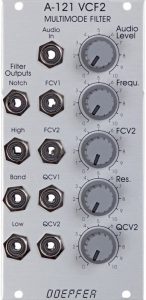The module is no longer in production.
The A-121 is an early but very neat filter design by Doepfer. Unfortunately, the Curtis module CEM 3320 used is no longer available, so the module is no longer commercially available. It’s a shame because it has a very unique sound character and some interesting technical features.
From the dimensions, which seem almost “baroque” nowadays, you can quickly see that we are dealing with a very early design by Doepfer. Yes, somehow the 12 TE are almost a waste of space for such a “simple” filter module. But the diverse modulation options (TWO inputs for the modulation of the resonance!) and the generous space between the control elements also allow a very comfortable working with the module. Everything has its price (and its justification, depending on what you want).
User interface
Inputs:
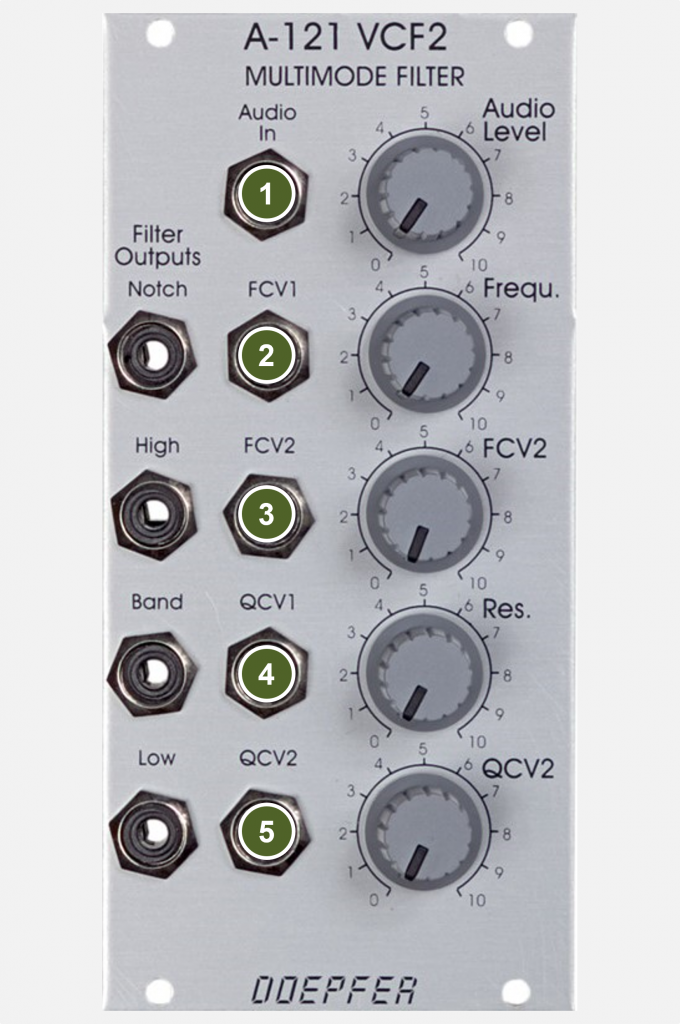
- Audio In: Audio input.
- FCV1: Control voltage input for the cutoff-frequency (without attenuator).
- FCV2: Control voltage input for the cutoff-frequency (with attenuator “FCV2”).
- QCV1: Control voltage input for the resonance of the filter (without attenuator).
- QCV2: Control voltage input for the resonance of the filter (with attenuator “QCV2”).
Outputs:
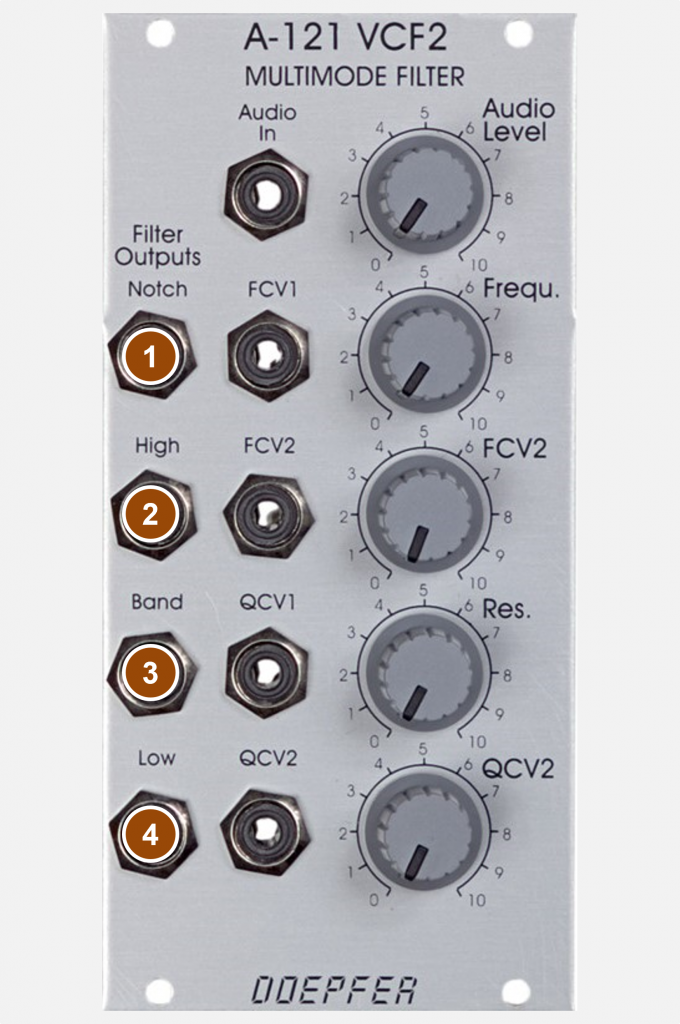
- Notch: Audio output for the notch filter mode (band stop).
- High: Audio output for the highpass filter mode.
- Band: Audio output for the bandpass filter mode.
- Low: Audio output for the lowpass filter mode.
Controls:
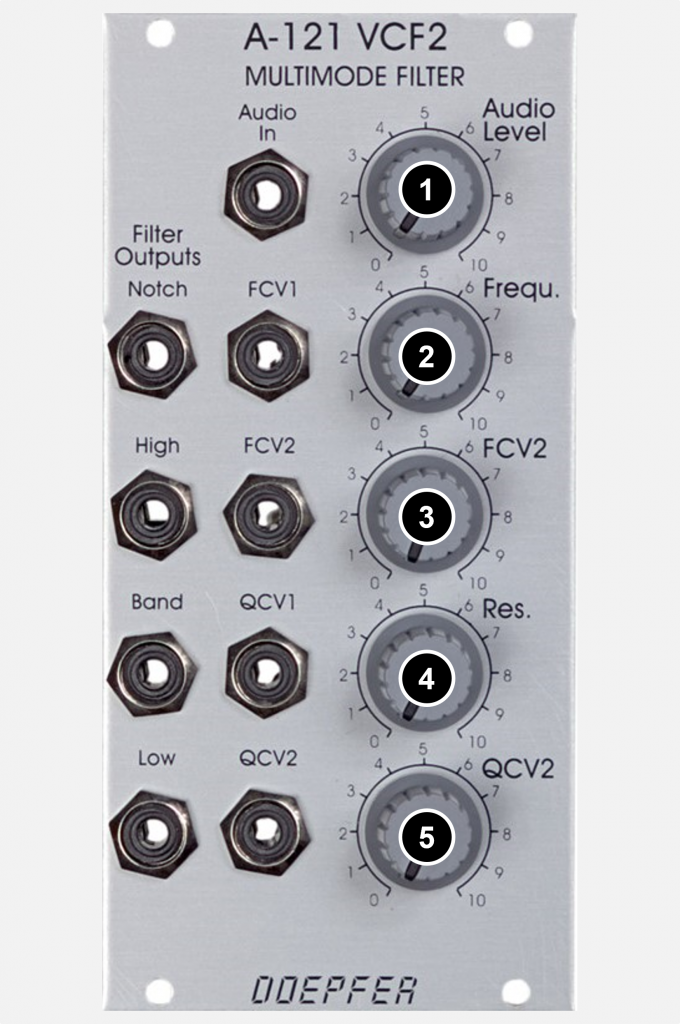
- Audio Level: Attenuator for the audio input.
- Frequ.: Control for the cutoff-frequency, affects all filter modes.
- FCV2: Attenuator for the control voltage input “CV2”.
- Res.: Controller for the resonance of the filter.
- QCV2: Attenuator for the control voltage input “QCV2” (to control the resonance).
Highpass with self-oscillation
A special feature in terms of sound: the A-121 is one of the few high-pass filters with the option of self-oscillation (the A-101-1 can also self-oscillate in high-pass mode, but is quite “sensitive” to the starting point and clipping).
Accurate Tracking (1V/Octave)
The cutoff-frequency and thus the frequency of the sine tone during self-oscillation can (at least in my example) be controlled very precisely (1 V / octave). This makes the filter ideal for use as a tonally playable sine wave oscillator.
Crossfading of the individual outputs
Like all multimode filters, the A-121 is very versatile. Similar to the A-106-6, smooth transitions between different filter modes can also be achieved thanks to the 4 individual outputs with the help of a voltage-controlled mixer or crossfader.
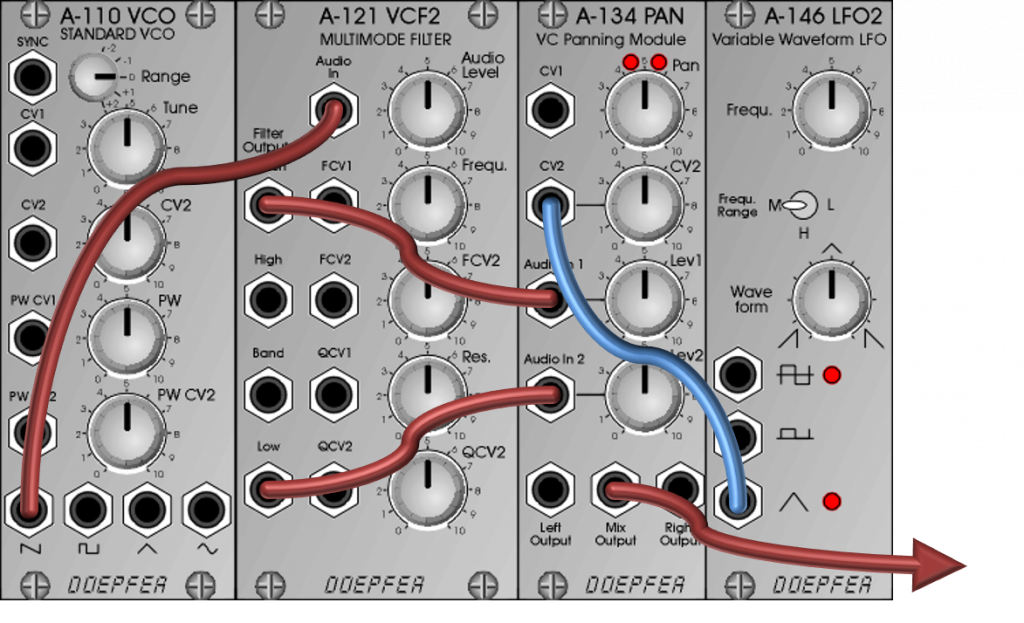
Alternatives
The A-121 module, which is unfortunately no longer in production, has a successor: the A-121-2 multimode filter. It is significantly narrower with 8 TE and basically offers almost the same functionality (only restriction: only one input for modulating the resonance). However, it sounds significantly different than its somewhat “rougher” predecessor.
And the A-121-2 now also has a “successor”, which does not replace the module, but represents a space-saving alternative: The A-121-3 multimode filter is almost identical to the A-121-2, but as a “Slim Line” module it only requires 4 HP of rack space.
The new A-121s has the same filter technology, but is luxuriously and elaborately designed for stereo use. Here you can seamlessly fade between the different filter modes.
Sound examples
-
A-121 / Sequence with different filter modes
In this example, the sawtooth outputs of three A-110-1 VCOs are used, with one VCO transposed down an octave. The VCOs are controlled by an A-155 sequencer. The audio levels for the filter input are comparatively high to show the typical distortion caused by the A-121 filter. The filter output still goes into an A-132-3 VCA, which is controlled by an A-140.
We start with the notch filter (0:00-1:22), then highpass (1:22-2:53), bandpass mode (2:53-4:30) and lowpass (4:30-6:17). In each of the 4 passes, I start with no resonance and a very slow LFO that modulates the filter cutoff frequency. Then I slowly increase the resonance to the maximum, add ADSR modulation to the filter cutoff frequency, slowly decrease the resonance back to zero and finally fade out.
Sequence with the A-121. -
A-121, A-121-2 / Comparison of the filters
In the following sound examples I would like to compare the A-121-2 directly with its predecessor, the A-121. Both filters are fed by 3 A-110-1 VCOs (sawtooth outputs, one VCO is transposed 1 octave down). An A-155 sequencer controls the VCOs and two A-140 ADSR generators, which control the filter and the downstream A-132-3 VCA.
With each pass, I start with the maximum filter cutoff frequency, which I manually turn to “0” and then back to the maximum. All settings are the same, due to the significantly higher input gain of the A-121-2, the recording level is slightly reduced there to avoid clipping.
For each filter mode there is a pass with resonance (or “Q”) at 0, at 5 and at 10. The input level is in the middle position at 5. On a fourth run, the input level is at 10 (thus causing distortion of the input signal), the resonance/Q is at 5.
Notch filter:
A-121: Resonance = 0. A-121-2: Resonance =0. A-121: Resonance = 5. A-121-2: Resonance = 5. A-121: Resonance = 10. A-121-2: Resonance = 10. A-121: Input Level = 10 (Res. 5). A-121-2: Input Level = 10 (Res. 5). Highpass filter:
A-121: Resonance = 0. A-121-2: Resonance = 0. A-121: Resonance = 5. A-121-2: Resonance = 5. A-121: Resonance = 10. A-121-2: Resonance = 10. A-121: Input Level = 10 (Res. 5) A-121-2: Input Level = 10 (Res. 5). Bandpass filter:
A-121: Resonance = 0. A-121-2: Resonance = 0. A-121: Resonance = 5. A-121-2: Resonance = 5. A-121: Resonance = 10. A-121-2: Resonance = 10. A-121: Input Level = 10 (Res. 5) A-121-2: Input Level = 10 (Res. 5). Lowpass filter:
A-121: Resonance = 0. A-121-2: Resonance = 0. A-121: Resonance = 5. A-121-2: Resonance = 5. A-121: Resonance = 10. A-121-2: Resonance = 10. A-121: Input Level = 10 (Res. 5) A-121-2: Input Level = 10 (Res. 5)
Technical specifications
| Width | 12 HP |
| Depth | 55 mm |
| Power requirements | 30 mA (+12V) / -20 mA (-12V) |
